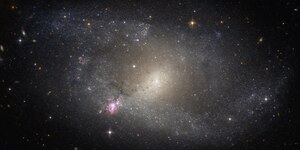NGC 5398
| Galaxy NGC 5398 |
|
|---|---|

|
|
| The galaxy NGC 5398 imaged by the Hubble Space Telescope . | |
| AladinLite | |
| Constellation | centaur |
|
Position equinox : J2000.0 , epoch : J2000.0 |
|
| Right ascension | 14 h 01 m 21.5 s |
| declination | -33 ° 03 ′ 50 ″ |
| Appearance | |
| Morphological type | SB (rs) dm |
| Brightness (visual) | 12.6 mag |
| Brightness (B-band) | 13.2 mag |
| Angular expansion | 2.8 ′ × 1.7 ′ |
| Position angle | 172 ° |
| Surface brightness | 14.1 mag / arcmin² |
| Physical data | |
| Redshift | 0.004066 ± 0.000010 |
| Radial velocity | 1219 ± 3 km / s |
|
Stroke distance v rad / H 0 |
(49 ± 4) · 10 6 ly (15.0 ± 1.1) Mpc |
| diameter | 55,000 ly |
| history | |
| discovery | John Herschel |
| Discovery date | June 3, 1836 |
| Catalog names | |
| NGC 5398 • UGC A 379 • PGC 49923 • ESO 384-032 • MCG -05-33-37 • IRAS 13584-3249 • 2MASX J14012155-3303496 • SGC 135826-3249.3 • GC 3734 • h 3552 • | |
NGC 5398 is a barred spiral galaxy of the Hubble type SB (rs) dm in the constellation Centaur in the southern sky . It is an estimated 49 million light years from the Milky Way and has a diameter of about 55,000 ly. NGC 5398 is home to the huge star formation region Tol 89, which is the subject of current studies. This area is 5000 by 4000 light years in size.
The galaxy NGC 5398 was discovered on June 3, 1836 by the British astronomer John Herschel .
Web links
Commons : NGC 5398 - collection of images, videos, and audio files
- The massive star population in the giant HII region Tol 89 in NGC 5398
- NGC 5398. SIMBAD, accessed February 14, 2016 .
- NGC 5398. DSO Browser, accessed February 14, 2016 .
